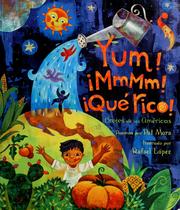YUM! MmMm! QUE RICO! AMERICAS' SPROUTINGS
By Pat Mora Illustrated by Rafael Lopez

Image Credit: www.openlibrary.org
1. Bibliography
Mora, Pat, and Rafael López. Yum! Mmmm! Qué Rico!: Americas' Sproutings. New York: Lee & Low, 2007. Print. ISBN 9781584302711
2. Plot Summary
Pat Mora includes fourteen haikus for food that is eaten in various regions of the Americas. A side note is included for each food item that tells the reader where the origin of the food and some fun facts including how the food is used today.
3. Critical Analysis
Pat Mora introduces the readers to food that is used and enjoyed by many people. The poems are listed in alphabetical order starting with blueberries and ending with vanilla. Many of the haikus tell the reader what the food is used for. "Prickly Pear Red desert wonder. Cactus fruit becomes syrup and dulces. Surprise!" Mora includes a short section of information for each food. Children will be able to learn where the food is native from and how some of the items are used today. "Today the starch from corn kernels is used as a binder to help crayons and chalk hold together."
Cultural markers that are present include the use of words including los dulces, la luna, and que rico through out the story. A glossary of these words is located at the beginning of the book so readers can become familiar with these words before reading the haikus. Young children will enjoy the short haikus while older children will enjoy reading the facts about the food.
The illustrations are brightly colored with full pages which highlights the food haiku for that page. Many of the families and children in the illustrations look to be of Hispanic descent. Lopez includes a white child eating chocolate and an African American child with cranberries. We also see a Hispanic child eating tomatoes while his parents work the garden. Hispanic families eating pecans and corn tortillas is another cultural marker to show the importance of family. The landscapes include deserts, tropics, and houses such as a pueblo hut.
4. Review Experts
~ SCHOOL LIBRARY JOURNAL (9/2007): "PreS-Gr 3-This concept book serves as a delicious introduction to 14 types of food, all of which have their origins in the Americas. Snippets of information and a haiku poem accompany each one, ranging from blueberry and chili pepper through papaya, prickly pear, and vanilla. Using English and a smattering of Spanish words, Mora crafts a playful introduction to each one, as in "Pumpkin": "Under round luna,/scattered tumblings down the rows,/autumn's orange face." The sense of whimsy is further underscored in L-pez's colorful acrylic on wood-panel illustrations. Artful compositions and brilliant complementary colors bear out the book's multicultural themes. The art conveys an infectious sense of fun, as smiling suns and moons beam down upon happy children and animals, along with a trumpet-wielding peanut-butter sandwich and a dancing pineapple. Teachers will find this a welcome addition to their social-studies units, but it should also win a broad general audience for its inventive, fun-filled approach to an ever-popular topic: food."
~KIRKUS (9/2007): "Haiku celebrating the diversity of edible plants native to the Americas--blueberries, chocolate, prickly pears, pecans and more. Each spread includes an informative paragraph explaining the probable origin, history and some trivia for the plant described in the poem. (The word pecan, for example, comes from a French word meaning, "nut to be cracked on a rock.") Lopez's vibrant, folklorish illustrations make the book a visual feast, but the haikus are uneven. Some (Chiles: "Dad bites green mouth-fire / laughs when tears fill his eyes, sighs / 'Mmmm! This heat tastes good' ") evoke the essence of their subject; others (Potato: Underground magic. / Peel brown bundle, mash, pile high. / Salt and pepper clouds) are just confusing. More interesting as social science than as poetry, but visually gorgeous."
5. Connections
~Older students could write their own haiku of their favorite food.
~Students could choose a favorite food listed in this book and research more about the food item.
No comments:
Post a Comment